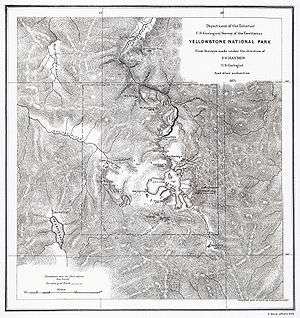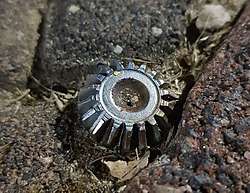Cadastral surveying
Cadastral surveying is the sub-field of cadastre and surveying that specialises in the establishment and re-establishment of real property boundaries. It is an important component of the legal creation of properties. A cadastral surveyor must apply both the spatial-measurement principles of general surveying and legal principles such as respect of neighboring titles.
Duties and role of a cadastral surveyor
.jpg)
One of the primary roles of the land surveyor is to determine the boundary of real property on the ground. That boundary has already been established and described in legal documents and official plans and maps prepared by attorneys, engineers, and other land surveyors. The corners of the property will either have been monumented by a prior surveyor, or monumented by the surveyor hired to perform a survey of a new boundary which has been agreed upon by adjoining land owners.
Principles of cadastral surveying
A common use of a survey is to determine a legal property boundary. The first stage in such a survey, known as a resurvey, is to obtain copies of the deed description and all other available documents from the owner. The deed description is that of the deed and not a tax statement or other incomplete document. The surveyor should then obtain copies of deed descriptions and maps of the adjoining properties, any records from the municipality or county, utility maps, and any records of surveys. Depending on which region the survey is located in, some or most of this information may not be available or even exist. Whether the information exists or not, a thorough search should be conducted so that no records are overlooked. Copies of deeds usually can be located in the government recorder's office, and maps or plats can usually be found at the recorder or surveyor's office. These arrangements will vary state-to-state and survey-system-to-survey system, so some familiarity may be needed.
When all the records are assembled, the surveyor examines the documents for errors, such as closure errors. When a metes and bounds description is involved, the seniority of the deeds must be determined. The title abstract usually gives the order of seniority for the deeds related to the tract being surveyed and should be used if available. After this data is gathered and analyzed the field survey may commence. The initial survey operations should be concentrated on locating monuments. In urban regions, monuments should be sought initially; but in the absence of monuments, property corners marked by iron pins, metal survey markers, iron pipes, and other features possibly establishing a line of possession should be located. When the approximate positions for the boundaries of the property have been located, a traverse is run around the property. While the control traverse is being run, ties should be measured and all details relevant to the boundaries should be acquired. This includes but is not limited to locating the property corners, monuments, fences, hedge rows, walls, walks, and all buildings on the lot. The surveyor then takes this collected data and compares it to the records which were received. When a solution is reached, the chosen property corners (those that best fit all the data) are coordinated, and ties by direction and distance are computed from the nearest traverse point. Once this has been established the features on the lot can be drawn, dimensions can be shown from these features to the boundary line, and a map or plat is prepared for the client.[1]
Monuments


Monuments are categorized into two groups which are known as natural and artificial. Natural monuments are things such as trees, large stones, and other substantial, naturally occurring objects that were in place before the survey was made. An artificial monument is anything within the regulations which marks the property boundary—having been placed by landowners, surveyors, engineers, or others. They may be referred to as iron pins or pipes, stakes, trees, concrete monuments, or whatever the surveyor decides to use at the time, within the regulations for the area. The courts have held that natural monuments take precedence over artificial monuments, because they are more certain in identification and less likely to be disturbed.[2]
Over time, construction and maintenance of roads and many other human acts, along with acts of nature such as earthquakes, movement of water, and tectonic shift can obliterate or damage the monumented locations of land boundaries. The land surveyor is often compelled to consider other evidence such as fence locations, wood lines, monuments on neighboring properties, and people's recollections. This other evidence is known as extrinsic evidence and is a fairly common principle. Extrinsic evidence is defined as evidence outside the writings, in this case evidence outside of the deed. Extrinsic evidence is held to be of equal value to evidence from another source.[3]
Today's land surveyor sets monuments at actual physical points on the ground that define angle points of boundary lines dividing neighboring land parcels. These monuments are most often 1⁄2 inch or 5⁄8 inch iron rebar rods or pipes placed at 18 inches minimum depth, but they vary from state by state. The more recent rods or pipes may have an affixed plastic cap over the top bearing the responsible surveyor's name and license number. Older monuments may exist such as old pipes, gun barrels, axles, mounds of stone, whiskey bottles, or even wooden stakes. In addition to rods and pipes, surveyors might use 4 inch × 4 inch concrete posts at the corners of large parcels or anywhere which requires greater stability (e.g. beach sand). They place the posts three feet deep.
In locations where there is asphalt or concrete, it is common to place nails or aluminum-alloy caps to re-establish boundary corners. Marks are meant to be durable, stable, and as "permanent" as possible. The aim is to provide sufficient marks so that some of them will remain for future re-establishment of boundaries. The material and marking used for monuments placed to mark boundary corners are often subject to state laws. Many states have laws that protect existing monuments and may apply civil penalties if the markers are disturbed or destroyed.
The art of land surveying
Many properties have considerable problems with regard to improper bounding or miscalculations in past surveys, titles, easements, and wildlife crossings. Also, many properties are created from multiple divisions of a larger piece over the course of years, and with every additional division the risk of miscalculation increases. The result can be abutting properties not coinciding with adjacent parcels, resulting in hiatuses (gaps) and overlaps. Many times a surveyor must solve a puzzle using pieces that do not exactly fit together. In these cases, the solution is based upon the surveyor's research and interpretation, along with established procedures for resolving discrepancies. This is essentially a process of continual error correction and update, where official recordation documents countermand the previous and sometime erroneous survey documents recorded by older monuments and older survey methods.
References
- Anderson, J., & Mikhail, E. (1998). Surveying: Theory and practice. (7th ed., p. 1011). McGraw-Hill.
- Brown, C., Wilson, D., & Robillard, W. (2003). Brown's boundary control and legal principles. (5th ed., p. 30). Hoboken, NJ: John Wiley & Sons, Inc.
- Richards, D., & Hermansen, K. (1995). "Use of extrinsic evidence to aid interpretation of deeds." Journal of Surveying Engineering, (121), 178.